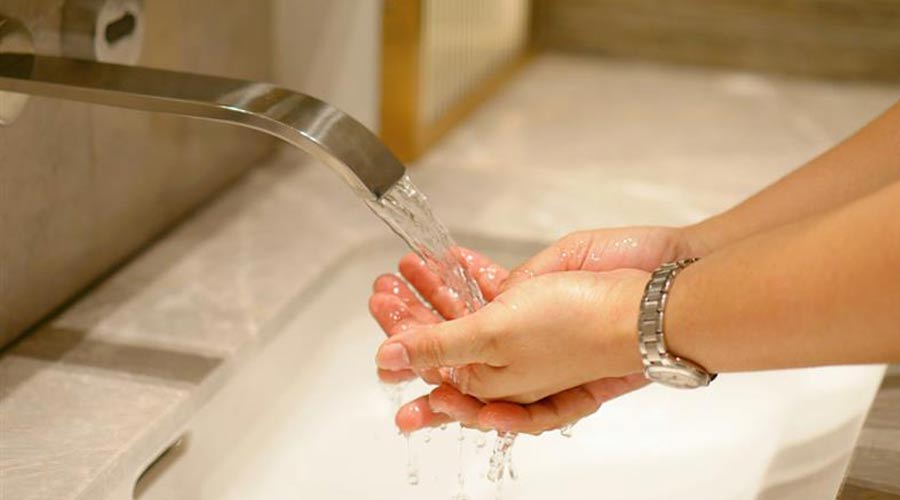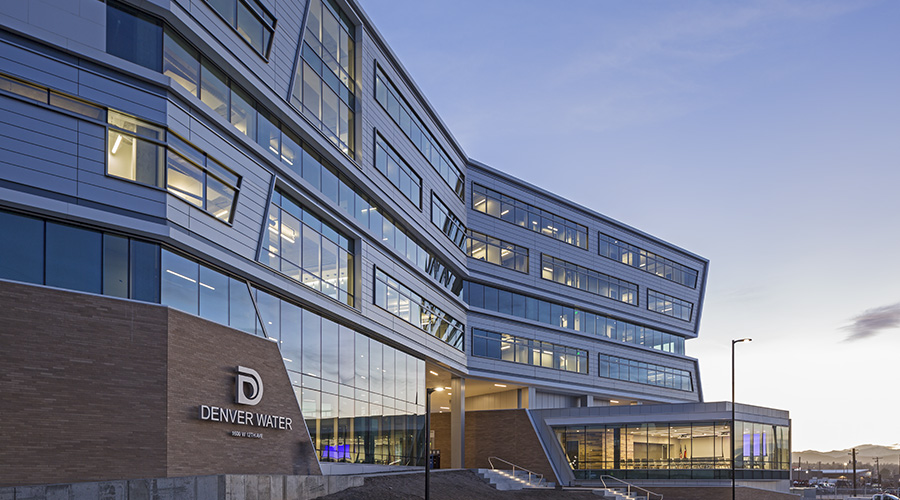Tips for Going Touchless
Managers with two large institutions discuss the benefits and challenges of successfully incorporating touch-free plumbing fixtures
Automatic, or touchless, plumbing fixtures were a rarity not that long ago, found largely in and handful of airports and convention centers.
In the last decade, however, important changes both in the technology and within facilities have brought touchless plumbing fixtures into all types of institutional and commercial buildings.
A closer look at the issues facing managers in two large institutional facilities reveals strategies for successful specification, installation and maintenance.
Evolving Issues
Three issues have changed greatly in the last decade to pave the way for touchless plumbing technology.
First, the durability and performance of the products has improved, making them more attractive to cost-conscious managers looking for products that need to stand up to high levels of use and even abuse.
"Manufacturers really have done a lot to make their products more reliable," says Michael Brady, director of maintenance and operations for the Los Angeles Unified School District (LAUSD). The district has been installing touchless plumbing fixtures in its schools since the mid-1990s.
The automatic control for touchless urinal and toilet fixtures uses an infrared sensor that activates the flushing mechanism only when it is needed and only for one flush. This technology eliminates too-frequent flushing and curtails damage from vandalism to the flush valve.
On sink faucets, touchless controls limit the flow of water to only when the sensor detects hands under the faucet. This feature can help reduce facilities water use by about 75 percent, and it can reduce damage from vandalism because users cannot leave the water running.
The second issue involves hygiene. Restroom users have become more concerned about the cleanliness of all fixtures and surfaces in restrooms. Because touchless fixtures eliminate the need for human contact, they eliminate the potential for germ transfer. And, when combined with touchless hand dryers and changes in restroom entryways, touchless plumbing fixtures can help managers carry the touchless concept even further.
Third, and perhaps most importantly, water utility costs have skyrocketed in recent years, prompting maintenance and engineering managers to find products and technology that curtail water use. Touchless fixtures, which shut off automatically the flow of water when not in use, address this need.
The fixtures "had been touted as a water-conservation measure, and the utility costs in Boston are quite high," says Thomas Tribble, P.E., J.D., director of facilities maintenance at Boston Medical Center. The medical center, the teaching hospital for Boston University's medical school, has 20 buildings with about 2 million square feet of space.
The savings from less post-installation maintenance also were attractive to the medical center.
"Even if we hadn't been ecology-minded, the cost to maintain the existing fixtures would have made us take a look at - touchless fixtures," he says.
Research and Selection
The selection process for flushometers at the Boston Medical Center included a test of both the time and the ease of installation of various products.
"We tested several different brands over about a two-month period," Tribble says. One model required an hour to install, another required about three hours, and still another took more than half a day. Because of the large number of restrooms and installations throughout the center's facilities, a short installation time was essential.
For the flush meters, Tribble's department chose a retrofit option from the maker of the existing fixtures instead of completely replacing the fixtures with those from another manufacturer.
"The other units we saw required more work to make the conversion," he says.
For the faucets, the department opted for a complete replacement. The decision on which manufacturer to go with came down to a matter of batteries, he says. The installed faucets require far less frequent battery replacement than those used by other manufacturers' models.
The challenge of keeping plumbing fixtures operational and efficient is immense in Los Angeles's schools. Brady's department is responsible for maintaining more than 66 million square feet in 900 facilities, including about 750 K-12 schools. The district also plans to add about 160 new schools in the next few years. This growth means the issue of water conservation in the schools - in Los Angeles and elsewhere in the Wester United States - will be increasingly important in coming years.
Renovation Planning
In many cases, organizations incorporate the installation of touchless fixtures into larger projects.
"Our goal is to end up with restrooms that are easier to maintain," Brady says. "We'll repipe everything if necessary." Renovations often also include new wall tile, floors, partitions, hand dryers, and lighting. Technicians also have upgraded electrical service to the restrooms to support the use of drain snakes and similar equipment.
The district has budgeted for about 108 student restroom renovations annually, Brady says. So far, crews have renovated about 950 out of 7,200 student restrooms.
At Boston Medical Center, installation started about two years ago on a trial basis. At this point, installations of touch-free fixtures have been limited to the medical center's public restrooms, not patient bathrooms.
"My goal is to have all fixtures in the hospital totally retrofitted in another three years," Tribble says.
Targeting vandalism and Hygiene
High rates of vandalism in parts of some of LAUSD's restrooms created a growing number of service requests, and district officials knew the situation required action.
"We looked at all of the (toilet) stoppage calls and identified high-use areas," Brady says. In response, the department installed touchless fixtures on toilets to curtail vandalism and minimize service calls because the toilets would flush automatically and more regularly, which also improves hygiene.
In making its fixture selection, the department tested two types of flush valves " hard-wired and battery powered. Hard-wired units created problems during power outages, and they were susceptible to water infiltration, Brady says. In addition, the higher cost to rough in the hard-wired units caused concerns.
Early generations of battery-powered units also had a few glitches. Batteries in some valves installed in restrooms with windows tended to drain quickly because sunlight repeatedly set off the sensors. Newer models have remedied this problem.
To complement touchless flush valves, eliminate paper and improve restroom hygiene, Brady says, the department also installed automatic hand dryers.
"In 1997, the district started its Smart Restroom program," Brady says. "Restroom renovations were based on set standards designed to make restrooms more vandal-proof and to keep them cleaner." In 2003, another district effort targeted restrooms and aimed to improve hygiene to meet community standards.
While vandalism is not epidemic in the district's facilities, Brady says, the issue continues to influence the department's choices of restroom products.
"We have a high rate of vandalism, but it's primarily in areas that are open to the public and have less supervision," he says. So far, the department has not installed touchless flush valves on all toilets, nor have they upgraded from traditional sink faucets to touchless fixtures.
The reason? The fixtures on many faucets and toilets remain easier targets for vandals than fixtures on urinals, which are more difficult to reach and kick, Brady says.
To address these challenges, manufacturers are using more durable materials and construction in each new generation of products. Among the remaining vandalism-related problems with the touchless valves are sensor lenses that are susceptible to scratching and convenience-flush buttons that vandals can pry out.
Waterless Issues
One of the latest products that aims to reduce water use in restrooms is the waterless urinal. Traditional systems use a water seal to prevent odors generated by the wastewater system from escaping into the restroom. Waterless urinals use disposable cartridges filled with a sealing liquid and, as a result, require no water to operate.
By eliminating valves, sensors and water, these urinals also eliminate problems associated with urinal overflow, splashing and vandalism. The only required service is replacing the cartridge every six months or so.
The amount of water that facilities can save depends on the application. For example, some users in school have estimated that each installed waterless urinal saves 10,000-40,000 gallons of water annually.
Facilities most often have installed waterless urinals in new construction projects and restroom renovations. Workers can retrofit the urinals into existing restrooms, but they might face problems created by differences in the height of the existing piping and the piping for the waterless unit.
Both Brady and Tribble are researching the performance of waterless urinals in other similar facilities. Neither seems eager to specify the products just yet, however.
Says Brady, "I've called other districts, and the reports (on the urinals) are not glowing."
Nonetheless, as with touchless technology, manufacturers of waterless urinals undoubtedly will ensure that future generations of their products address customers' needs for reliability, maintainability, and cost-effective operation.
Related Topics:











